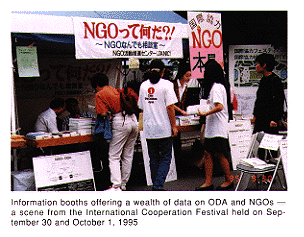Official Development Assistance (ODA)15. Publicity, Information Disclosure on ODA, and Development Education
The general public has few opportunities to observe ODA activities at first hand as most of them are carried out abroad. However, recognizing the size of Japan's ODA amounting to over ¥1,000 billion, which has made Japan the world's No. 1 donor in dollar terms for five years in a row, it is an important responsibility for the Government of Japan to strengthen its efforts to bring home the achievements of ODA activities.
(1) October 6 is the "International Cooperation Day"
The Government of Japan named October 6 "International Cooperation Day" to commemorate the date Japan joined in the Colombo Plan in 1954 and started its development assistance. Since 1987, various events have been held every year in many parts of the country to mark the day. "International Cooperation Festival," has been held in Tokyo since 1992 as part of the cooperation-day campaigns, with the participation of citizens interested in international assistance and many NGO members.
(2) Opening of "Plaza for International Cooperation" -- the Center for ODA Publicity
In October 1993, "Plaza for International Cooperation" was opened as a venue of communication among the general public interested in international cooperation. Opened by the Association for Promotion of International Cooperation, it is conveniently located -- a 3-minute walk from Hiroo Station on the Hibiya Subway Line. The plaza not only offers a wide range of data and information about ODA, but also serves as a place of information exchange. Recently an increasing number of junior high school students and primary school children use the space as part of their school excursion and extracurricular activities. More than 10,000 people visited the plaza in FY 1995 alone.
(3) Publications
The Government of Japan enhances disclosure of information on ODA by publishing the ODA White Paper (English version: Japan's Official Development Assistance Annual Report), Economic Cooperation Evaluation Report, Annual Report on the Implementation of Japan's ODA, other reports and a large variety of brochures and pamphlets. The white paper was highly rated in the Aid Review of Japan (Nov. 1995), announced by the Development Assistance Committee (DAC) of the OECD, as "the most comprehensive and handsome publication of its kind prepared by any DAC Member."
(4) Development Education
The training of researchers on development matters is of great significance as it provides intellectual support for aid policy and helps enhance the quality of ODA evaluation. For this reason, the Foundation for Advanced Studies on International Development (FASID) was established in 1990 to extend assistance for development-related research and to promote human resources on development.

